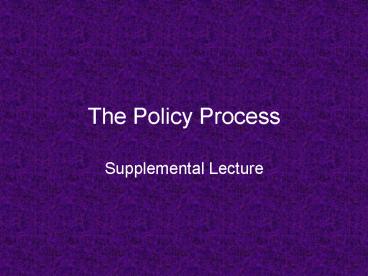The Policy Process - PowerPoint PPT Presentation
1 / 8
Title:
The Policy Process
Description:
Congress may need to adopt legislation or provide funding for any new policies ... The legislation creating the policy might have been vague or not specific enough; ... – PowerPoint PPT presentation
Number of Views:17
Avg rating:3.0/5.0
Title: The Policy Process
1
The Policy Process
- Supplemental Lecture
2
The Policy Process
- Problem identification and agenda formation
- Policy formation
- Policy adoption
- Policy implementation
- Policy evaluation
3
Problem identification
- Issue must come to be seen as a problem that has
a political solution - Issue can move onto the policy agenda in a number
of ways - The media might raise the issue
- An organized group within society might bring the
issue to the attention of politicians - Crisis or scientific research
- Personal interests of a specific politician
4
Policy Formulation
- A proposed policy (course of action) must be
developed - President may propose a policy
- Legislature may develop policy proposals
- Interest groups may present the government with
proposals or pressure the government to undertake
(or not undertake) specific actions - Government agencies may come up with solutions to
issues that fall under their area of operation
5
Policy Adoption
- Congress may need to adopt legislation or provide
funding for any new policies or the policy may be
developed by an existing governmental agency. - The process is highly political, with outside
groups on all sides of the issue trying to
influence the final policy. - The final policy will represent a compromise
between various interests.
6
Policy Implementation
- Once a policy is adopted, it must be carried out.
- Implementation can include any of the following
on the part of the responsible agency - Rule-making or detailing exactly how the
policy will be put into effect - Communicating the new policy and its requirements
to those affected by the policy - Setting penalties for non-compliance with the
policy
7
Policies often fail to be successfully implemented
- The agency responsible for that policy might not
have the resources necessary to properly
implement it - The legislation creating the policy might have
been vague or not specific enough - The agency responsible for carrying out the
policy might not support it and therefore resist
carrying it out - The policy might have been poorly designed to
start with - If the regulation affects an industry which does
not support the policy, that industry might try
to block its implementation by - overwhelming the government agency with
information or demanding public hearings in order
to slow down or even halt the process, - asking the White House to pressure the agency to
change its decisions, - filing suit against the agency to block the
policy, - pressuring Congress to reduce or eliminate
funding for the program.
8
Policy Evaluation
- Includes efforts to determine whether the policy
has been successful - May include various forms of research or informal
personal judgments of those involved - If the policy s judged to be unsuccessful or less
successful than desired, the process may begin
all over as the issue again is identified as
needing attention and re-enters to policy agenda.

